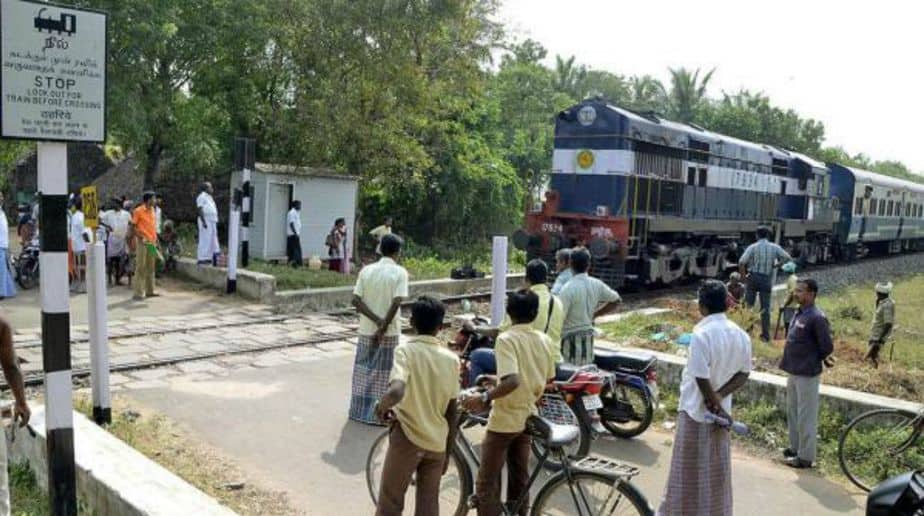
Railway level crossings have kind of nostalgic value, ingrained in our childhood memories and recounted many a time in contemporary literature. The waiting time at the level crossing for a train to pass was fairly long, more than half an hour sometimes, and spent rather impatiently. Some would step out of their cars and utilise the time buying fruits, vegetables and peanuts; even hot chai was available. Restless kids were tasked to count the number of coaches, as and when, the train chugged past, causing a mini-dust storm.
To kill time, people would walk in and around, ask the railway gateman which train is to arrive, and how long will it take. Sometimes, they’d realise to their dismay, that not one but two trains are going to pass —one of them a goods train. And all this while, pedestrians, rickshaw pullers and two-wheelers would continue crossing the tracks ducking under the horizontal pole which formed the barricade on either side of the tracks. A big round red signboard attached to the pole would state in bold capital letters: STOP.
In those good old days, some level crossings were notorious for causing traffic gridlocks. The cars, lorries, tractors and bullock cart would gather and clog the road while waiting for the train to pass. And accidents were common at the unmanned crossings, where somehow people and animals failed to hear the roar of a train just seconds away.
Last week, Railway Minister Piyush Goyal announced via a tweet that to ensure safety and eliminate risk, Indian Railways has extended the deadline for removal of all unmanned level crossings on major routes. “Bridges and subways have been constructed at crossings for the safe transit of vehicles and pedestrians,” he tweeted. The plan is to get rid of all level crossings, with priority to the unmanned ones.
It’s a great move, given more than 60 per cent of all fatalities of train accidents happen at unmanned level crossings. In the last decade, more than a thousand people have died in such accidents, the highest count for a year was in 2011-12 when 204 were killed.
There are numerous examples of these avoidable tragedies. The famous Medak mishap that killed 20 school children near Hyderabad in 2014. In another ghastly accident in 2011, 38 people were killed when Chhapra-Mathura Express train collided with a bus carrying 100 people of a wedding party—some survived to recount the tragedy—at an unmanned railway crossing in Kanshiram Nagar.
The most recent accident took place in April this year, when 13 school children were killed when a speeding passenger train crashed into a van carrying 20 students of Divine Mission School at an unmanned level crossing in Kushinagar district of Uttar Pradesh. The driver, Neyaz Ahmad, 22 years of age, allegedly had earphones plugged in while driving. Therefore, lately the focus was on Uttar Pradesh, IR identified such 121 unmanned crossings.
The elimination of level crossings by building overbridges has been a work in progress for some years now. As per the annual report of Indian Railways (IR), “As on 01.04.2015, IR has 29,487 level crossings out of which, 19,047 (65%) are manned and balance 10.440 (35%) are unmanned. IR has decided to progressively eliminate the level crossing for the safety of road users and train passengers.”
Further, “During the year 2014-15 (for instance) 1,148 unmanned level crossing and 310 manned level crossing have been eliminated. During the year 2015-16 (upto September ’15) 430 of unmanned level crossing and 129 of manned level crossings have been eliminated. Road over/under bridges to improve safety of train operation and reduce inconvenience.” The 12th Five Year Plan (2012-17) targeted to eliminate 9,808 level crossings in the Plan period and not add any new unmanned level crossing in future.
The situation has fairly improved in the last few years. As far as unmanned level crossing are concerned, only 600 of them remain. Indian Railways needs another five months to get rid of them completely either by constructing bridges or subways or by manning them. Thankfully, unammed level crossings have already been eliminated from the major routes where fast trains run, those that can gain speed of 130 km per hour.
There’s another reason to do away with level crossings. It’s a difficult task to man them. Earlier this week, the gateman of a level crossing near Delhi-Haryana border, Kundan Pathak, a resident of Bishanpur in Bihar’s Banka district, was attacked by lumpen elements. The 28-year-old Pathak’s hands were hacked by two bike-borne assailants when Pathak refused to open the level crossing gate as the Muri Express was approaching. Pathak underwent a four-hour surgery later where his limbs were reattached. Last heard, his condition is stable.
Level crossings and the risks they offer have no place in modern India.
The Delhi and District Cricket Association spent over Rs 10 crore on litigation and professional…
The authorised representative of Castrol Ltd. joined the raid and confirmed that the seized products…
Commuters have been advised to avoid certain roads between 12 noon and 11 pm on…
During a search of their vehicle, police found 1.068 kg of charas, 98 grams of…
The alleged assault is linked to a dispute over some staff members allegedly cutting the…
This will play a decisive role in providing villagers with legal proof of ownership and…